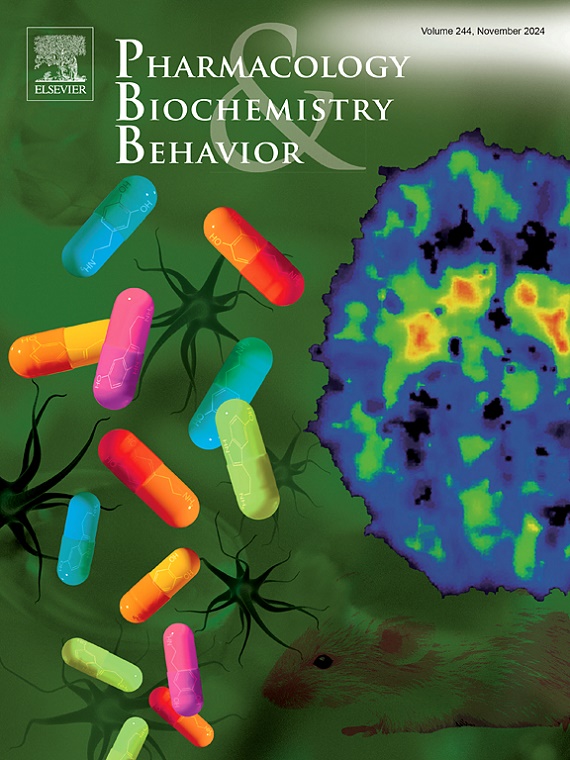Re-socialization reduces social isolation-induced high alcohol preference and anxiety via possibly restoring dopamine-rewarding effects in the rat striatum
IF 3.3
3区 心理学
Q1 BEHAVIORAL SCIENCES
引用次数: 0
Abstract
Social environmental factors frequently play an important role in early-life. It is reported that isolation increases vulnerability to develop alcohol use disorder. We investigated the effects of re-socialization on high alcohol preference and anxiety behaviors, induced by early-life social isolation (SI), and its possible underlying mechanism in male Wistar rats. On the 21st postnatal day, animals were either housed in groups of (CON) or isolated (SI-1) for the first stage (3 weeks). Afterwards, the SI-1 group were divided into two groups: re-socialization with socially housed rats (Re-SH) and isolation (SI-2) for a second stage (3 weeks). Both alcohol preference and behaviour tests were performed in these two stages. The ratio of dopamine content in striatum tissue was measured. The results showed that SI considerably induced the high alcohol preference and increased anxiety-like behaviors. However, during the 2nd stage, peer companionship significantly reduced the high alcohol preference and anxiety-like behaviors which were induced by early-life SI. Moreover, the striatal dopamine content was significantly enhanced by SI, but was evidently suppressed by re-socialization. Additionally, there was no statistical difference in body weight, anxiety-like behaviour, alcohol preference or dopamine content when the rats were only isolated during the SI-2 stage. It suggests that both the high alcohol preference and anxiety-like behaviors are able to be significantly reduced by re-socialization, which is possibly associated with regulating dopamine concentration.
通过可能恢复大鼠纹状体中多巴胺奖励效应,再社会化减少了社会隔离引起的高酒精偏好和焦虑
社会环境因素通常在早期生活中起着重要作用。据报道,孤立会增加患酒精使用障碍的脆弱性。我们研究了再社会化对雄性Wistar大鼠早期社会隔离(SI)诱导的高酒精偏好和焦虑行为的影响及其可能的潜在机制。第1阶段(3周)在出生后第21天,将各组(CON)或隔离(SI-1)饲养。随后,将SI-1组分为两组,第二阶段(3周):与社会饲养大鼠再社会化(Re-SH)和隔离(SI-2)。在这两个阶段进行了酒精偏好和行为测试。测定纹状体组织中多巴胺含量的比值。结果表明,SI显著诱导了高酒精偏好和增加的焦虑样行为。然而,在第二阶段,同伴陪伴显著降低了早期SI引起的高度酒精偏好和焦虑样行为。此外,纹状体多巴胺含量在SI作用下显著增加,但在再社会化作用下被明显抑制。此外,在SI-2阶段,当大鼠仅被隔离时,在体重、焦虑样行为、酒精偏好或多巴胺含量方面没有统计学差异。这表明,高度酒精偏好和焦虑样行为都可以通过再社会化显著减少,这可能与调节多巴胺浓度有关。
本文章由计算机程序翻译,如有差异,请以英文原文为准。
求助全文
约1分钟内获得全文
求助全文
来源期刊
CiteScore
6.40
自引率
2.80%
发文量
122
审稿时长
38 days
期刊介绍:
Pharmacology Biochemistry & Behavior publishes original reports in the areas of pharmacology and biochemistry in which the primary emphasis and theoretical context are behavioral. Contributions may involve clinical, preclinical, or basic research. Purely biochemical or toxicology studies will not be published. Papers describing the behavioral effects of novel drugs in models of psychiatric, neurological and cognitive disorders, and central pain must include a positive control unless the paper is on a disease where such a drug is not available yet. Papers focusing on physiological processes (e.g., peripheral pain mechanisms, body temperature regulation, seizure activity) are not accepted as we would like to retain the focus of Pharmacology Biochemistry & Behavior on behavior and its interaction with the biochemistry and neurochemistry of the central nervous system. Papers describing the effects of plant materials are generally not considered, unless the active ingredients are studied, the extraction method is well described, the doses tested are known, and clear and definite experimental evidence on the mechanism of action of the active ingredients is provided.

 求助内容:
求助内容: 应助结果提醒方式:
应助结果提醒方式:


